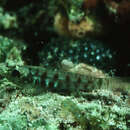Diagnostic Description
provided by Fishbase
This species is distinguished by the following characters: cephalic sensory-canal pore system without the IT pore only (pattern 2); branched pectoral-fin rays; fimbriate urogenital papilla; dorsal/anal-fin formula 9/8; fifth pelvic-fin ray rudimentary or absent; pectoral-fin base no dark spots; subcutaneous bars on body 5 between anal-fin origin and caudal fin; a large rectangular dark spot on mid and upper caudal peduncle (Ref. 107299).Description: semi-translucent green body with seven vertically elongate, dusky red blotches along upper side, last overlaying vertically elongate black spot on posterior caudal peduncle; side of body with similar blotches along lower side of body; head with dusky orange spots and short bands; first and second dorsal spines of male may be filamentous; eleventh to fifteenth pectoral rays usually branched; longitudinal scale series 23-24; ctenoid scales, absent on head, nape, breast and base of pectoral fin; separated pelvic fins, thin membrane joining bases; fifth pelvic rays absent or rudimentary; fourth pelvic ray with average of 7.6 branches; depth of body 4.4-5.0 in SL (Ref. 90102).
Morphology
provided by Fishbase
Dorsal spines (total): 6 - 7; Dorsal soft rays (total): 8 - 10; Analspines: 1; Analsoft rays: 7 - 8
Biology
provided by Fishbase
Inhabits algal covered rocks, rubble, or corals (Ref. 1602).
- Recorder
- Estelita Emily Capuli
Distribution
provided by World Register of Marine Species
Known from Western Australia (Ashmore Island and Dampier Archipelago), Indonesia (Waigeo, Java, and Celebes Sea); north to Philippines, Taiwan, and Japan; and south to Great Barrier Reef and Lord Howe Island. Records for Oceania include Micronesia (Marshall Islands, Kagingamarangi, FSM), New Caledonia, Fiji, Tonga, the Samoan Islands to French Polynesia (Society Islands) and Pitcairn Islands. Most of the collections seem to be from relatively shallow water.
Greenfield, D. W.; Randall, J. E. (2016). A review of the dwarfgobies of Fiji, including descriptions of five new species (Teleostei: Gobiidae: Eviota). Zenodo.
- license
- cc-by-4.0
- copyright
- WoRMS Editorial Board

